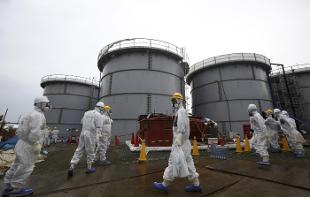- Fukushima, government and central will have to pay damages of the nuclear disaster
- Fukushima: start of the nuclear accident trial, 3 TEPCO executives at the counter
- Fukushima, peak of thyroid cancer in children
- Greenpeace: "The decontamination program is failing in Fukushima"
- Japan, restarted the first nuclear reactor after Fukushima. Activists protest in the square
Share
March 01, 2018 At seven years since the nuclear accident of March 11, 2011, the situation in Fukushima is still very serious, with some areas showing radioactive contamination values up to 100 times higher than the norms. Greenpeace Japan makes it known today spreading an analysis on the situation of contaminated areas.These are the main results of the report. Even after decontamination, in four of the six Iitate homes, average radiation levels are three times higher than the long-term government goal. Some areas have shown an increase compared to the previous year which could derive from recontamination.
In a house in Tsushima, in the Namie exclusion zone, a dose of 7 mSv per year is estimated, while the international limit for public exposure in a non-accidental situation is 1 mSv / year. All this despite the fact that it is an area used as a test bench for decontamination in 2011-12. A fact that evidently reveals the ineffectiveness of the decontamination work.
In a school in Namie children at risk
Still according to the analysis of Greenpeace Japan, in a school in the city of Namie, where the evacuation order was revoked, the decontamination failed to significantly reduce the risks of radiation, with levels in a nearby forest with an average rate dose over 10 mSv per year. Serious situation, given that children are particularly exposed to the risk of radiation exposure.
In an area of Obori, the massive level of radiation measured would give the equivalent of 101 mSv per year, or a hundred times the recommended maximum annual limit, assuming that a person remains there for a whole year. This high level of radioactive exposure is clearly a threat, above all for the thousands of workers involved in decontamination, who will have to spend many hours in that area.
Last November, UNHCR's Universal Periodic Review (UN High Commissioner for Refugees) on Japan issued four recommendations on the Fukushima problems. The governments of the Member States (Austria, Portugal, Mexico and Germany) have asked Japan to respect the human rights of the Fukushima displaced persons and to take strong measures to reduce the radiation risks for citizens, in particular women and children, and to support fully displaced.
Germany has invited Japan to return to the maximum permissible radiation of 1 mSv per year, while the current Japanese government policy is to allow exposures up to 20 mSv per year. If this recommendation were to be adopted, the Japanese government could not bring the population back into the contaminated areas.
"The government will stop forcing people to go home"
"The Japanese government must stop forcing people to return home and must protect the rights of its citizens - says Kazue Suzuki, from the Greenpeace Japan Energy campaign - It is essential that the government fully accepts and immediately applies the UN recommendations. The results of our radiation contamination surveys provide evidence that there is a significant risk to the health and safety of a possible return of evacuees ".

